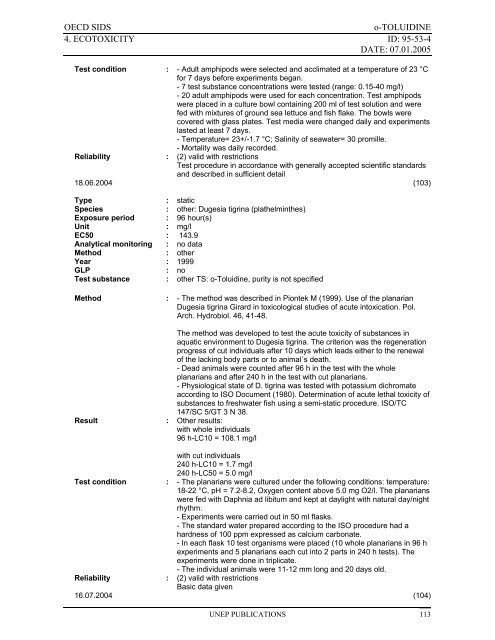o-TOLUIDINE CAS N°: 95-53-4 - UNEP Chemicals
o-TOLUIDINE CAS N°: 95-53-4 - UNEP Chemicals
o-TOLUIDINE CAS N°: 95-53-4 - UNEP Chemicals
You also want an ePaper? Increase the reach of your titles
YUMPU automatically turns print PDFs into web optimized ePapers that Google loves.
OECD SIDS o-<strong>TOLUIDINE</strong><br />
4. ECOTOXICITY ID: <strong>95</strong>-<strong>53</strong>-4<br />
DATE: 07.01.2005<br />
Test condition : - Adult amphipods were selected and acclimated at a temperature of 23 °C<br />
for 7 days before experiments began.<br />
- 7 test substance concentrations were tested (range: 0.15-40 mg/l)<br />
- 20 adult amphipods were used for each concentration. Test amphipods<br />
were placed in a culture bowl containing 200 ml of test solution and were<br />
fed with mixtures of ground sea lettuce and fish flake. The bowls were<br />
covered with glass plates. Test media were changed daily and experiments<br />
lasted at least 7 days.<br />
- Temperature= 23+/-1.7 °C; Salinity of seawater= 30 promille.<br />
- Mortality was daily recorded.<br />
Reliability : (2) valid with restrictions<br />
Test procedure in accordance with generally accepted scientific standards<br />
and described in sufficient detail<br />
18.06.2004 (103)<br />
Type : static<br />
Species : other: Dugesia tigrina (plathelminthes)<br />
Exposure period : 96 hour(s)<br />
Unit : mg/l<br />
EC50 : 143.9<br />
Analytical monitoring : no data<br />
Method : other<br />
Year : 1999<br />
GLP : no<br />
Test substance : other TS: o-Toluidine, purity is not specified<br />
Method : - The method was described in Piontek M (1999). Use of the planarian<br />
Dugesia tigrina Girard in toxicological studies of acute intoxication. Pol.<br />
Arch. Hydrobiol. 46, 41-48.<br />
The method was developed to test the acute toxicity of substances in<br />
aquatic environment to Dugesia tigrina. The criterion was the regeneration<br />
progress of cut individuals after 10 days which leads either to the renewal<br />
of the lacking body parts or to animal´s death.<br />
- Dead animals were counted after 96 h in the test with the whole<br />
planarians and after 240 h in the test with cut planarians.<br />
- Physiological state of D. tigrina was tested with potassium dichromate<br />
according to ISO Document (1980). Determination of acute lethal toxicity of<br />
substances to freshwater fish using a semi-static procedure. ISO/TC<br />
147/SC 5/GT 3 N 38.<br />
Result : Other results:<br />
with whole individuals<br />
96 h-LC10 = 108.1 mg/l<br />
with cut individuals<br />
240 h-LC10 = 1.7 mg/l<br />
240 h-LC50 = 5.0 mg/l<br />
Test condition : - The planarians were cultured under the following conditions: temperature:<br />
18-22 °C, pH = 7.2-8.2, Oxygen content above 5.0 mg O2/l. The planarians<br />
were fed with Daphnia ad libitum and kept at daylight with natural day/night<br />
rhythm.<br />
- Experiments were carried out in 50 ml flasks.<br />
- The standard water prepared according to the ISO procedure had a<br />
hardness of 100 ppm expressed as calcium carbonate.<br />
- In each flask 10 test organisms were placed (10 whole planarians in 96 h<br />
experiments and 5 planarians each cut into 2 parts in 240 h tests). The<br />
experiments were done in triplicate.<br />
- The individual animals were 11-12 mm long and 20 days old.<br />
Reliability : (2) valid with restrictions<br />
Basic data given<br />
16.07.2004 (104)<br />
<strong>UNEP</strong> PUBLICATIONS 113
















